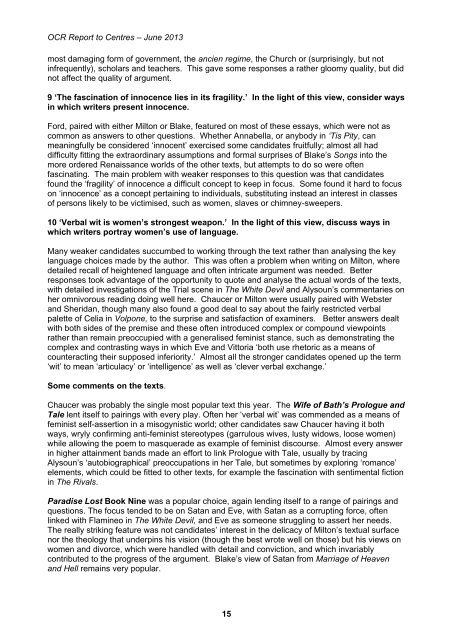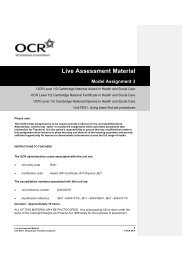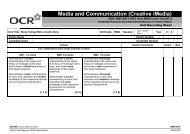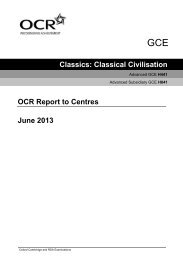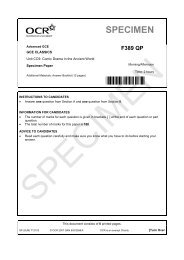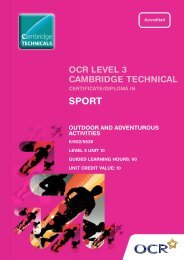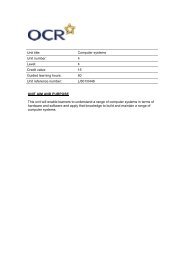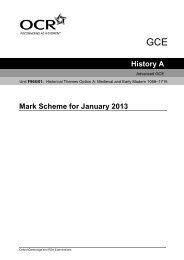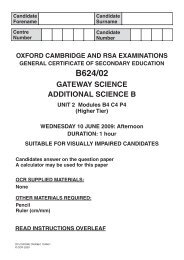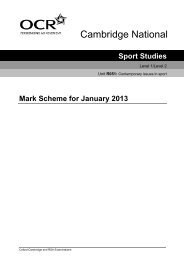Examiners' reports - June (PDF, 385KB) - OCR
Examiners' reports - June (PDF, 385KB) - OCR
Examiners' reports - June (PDF, 385KB) - OCR
You also want an ePaper? Increase the reach of your titles
YUMPU automatically turns print PDFs into web optimized ePapers that Google loves.
<strong>OCR</strong> Report to Centres – <strong>June</strong> 2013<br />
most damaging form of government, the ancien regime, the Church or (surprisingly, but not<br />
infrequently), scholars and teachers. This gave some responses a rather gloomy quality, but did<br />
not affect the quality of argument.<br />
9 ‘The fascination of innocence lies in its fragility.’ In the light of this view, consider ways<br />
in which writers present innocence.<br />
Ford, paired with either Milton or Blake, featured on most of these essays, which were not as<br />
common as answers to other questions. Whether Annabella, or anybody in ‘Tis Pity, can<br />
meaningfully be considered ‘innocent’ exercised some candidates fruitfully; almost all had<br />
difficulty fitting the extraordinary assumptions and formal surprises of Blake’s Songs into the<br />
more ordered Renaissance worlds of the other texts, but attempts to do so were often<br />
fascinating. The main problem with weaker responses to this question was that candidates<br />
found the ‘fragility’ of innocence a difficult concept to keep in focus. Some found it hard to focus<br />
on ‘innocence’ as a concept pertaining to individuals, substituting instead an interest in classes<br />
of persons likely to be victimised, such as women, slaves or chimney-sweepers.<br />
10 ‘Verbal wit is women’s strongest weapon.’ In the light of this view, discuss ways in<br />
which writers portray women’s use of language.<br />
Many weaker candidates succumbed to working through the text rather than analysing the key<br />
language choices made by the author. This was often a problem when writing on Milton, where<br />
detailed recall of heightened language and often intricate argument was needed. Better<br />
responses took advantage of the opportunity to quote and analyse the actual words of the texts,<br />
with detailed investigations of the Trial scene in The White Devil and Alysoun’s commentaries on<br />
her omnivorous reading doing well here. Chaucer or Milton were usually paired with Webster<br />
and Sheridan, though many also found a good deal to say about the fairly restricted verbal<br />
palette of Celia in Volpone, to the surprise and satisfaction of examiners. Better answers dealt<br />
with both sides of the premise and these often introduced complex or compound viewpoints<br />
rather than remain preoccupied with a generalised feminist stance, such as demonstrating the<br />
complex and contrasting ways in which Eve and Vittoria ‘both use rhetoric as a means of<br />
counteracting their supposed inferiority.’ Almost all the stronger candidates opened up the term<br />
‘wit’ to mean ‘articulacy’ or ‘intelligence’ as well as ‘clever verbal exchange.’<br />
Some comments on the texts.<br />
Chaucer was probably the single most popular text this year. The Wife of Bath’s Prologue and<br />
Tale lent itself to pairings with every play. Often her ‘verbal wit’ was commended as a means of<br />
feminist self-assertion in a misogynistic world; other candidates saw Chaucer having it both<br />
ways, wryly confirming anti-feminist stereotypes (garrulous wives, lusty widows, loose women)<br />
while allowing the poem to masquerade as example of feminist discourse. Almost every answer<br />
in higher attainment bands made an effort to link Prologue with Tale, usually by tracing<br />
Alysoun’s ‘autobiographical’ preoccupations in her Tale, but sometimes by exploring ‘romance’<br />
elements, which could be fitted to other texts, for example the fascination with sentimental fiction<br />
in The Rivals.<br />
Paradise Lost Book Nine was a popular choice, again lending itself to a range of pairings and<br />
questions. The focus tended to be on Satan and Eve, with Satan as a corrupting force, often<br />
linked with Flamineo in The White Devil, and Eve as someone struggling to assert her needs.<br />
The really striking feature was not candidates’ interest in the delicacy of Milton’s textual surface<br />
nor the theology that underpins his vision (though the best wrote well on those) but his views on<br />
women and divorce, which were handled with detail and conviction, and which invariably<br />
contributed to the progress of the argument. Blake’s view of Satan from Marriage of Heaven<br />
and Hell remains very popular.<br />
15


